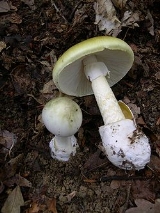
Death cap
Overview
Amanita phalloides commonly known as the death cap, is a deadly poisonous basidiomycete fungus
, one of many in the genus Amanita
. Widely distributed across Europe
, A. phalloides forms ectomycorrhizas with various broadleaved trees. In some cases, death cap has been introduced to new regions with the cultivation of non-native species of oak
, chestnut
, and pine. The large fruiting bodies (mushroom
s) appear in summer and autumn; the caps
are generally greenish in color, with a white stipe
and gills.
Coincidentally, these toxic mushrooms resemble several edible species (most notably caesar's mushroom and the straw mushroom) commonly consumed by humans, increasing the risk of accidental poison
ing.
Fungus
A fungus is a member of a large group of eukaryotic organisms that includes microorganisms such as yeasts and molds , as well as the more familiar mushrooms. These organisms are classified as a kingdom, Fungi, which is separate from plants, animals, and bacteria...
, one of many in the genus Amanita
Amanita
The genus Amanita contains about 600 species of agarics including some of the most toxic known mushrooms found worldwide. This genus is responsible for approximately 95% of the fatalities resulting from mushroom poisoning, with the death cap accounting for about 50% on its own...
. Widely distributed across Europe
Europe
Europe is, by convention, one of the world's seven continents. Comprising the westernmost peninsula of Eurasia, Europe is generally 'divided' from Asia to its east by the watershed divides of the Ural and Caucasus Mountains, the Ural River, the Caspian and Black Seas, and the waterways connecting...
, A. phalloides forms ectomycorrhizas with various broadleaved trees. In some cases, death cap has been introduced to new regions with the cultivation of non-native species of oak
Oak
An oak is a tree or shrub in the genus Quercus , of which about 600 species exist. "Oak" may also appear in the names of species in related genera, notably Lithocarpus...
, chestnut
Chestnut
Chestnut , some species called chinkapin or chinquapin, is a genus of eight or nine species of deciduous trees and shrubs in the beech family Fagaceae, native to temperate regions of the Northern Hemisphere. The name also refers to the edible nuts they produce.-Species:The chestnut belongs to the...
, and pine. The large fruiting bodies (mushroom
Mushroom
A mushroom is the fleshy, spore-bearing fruiting body of a fungus, typically produced above ground on soil or on its food source. The standard for the name "mushroom" is the cultivated white button mushroom, Agaricus bisporus; hence the word "mushroom" is most often applied to those fungi that...
s) appear in summer and autumn; the caps
Pileus (mycology)
The pileus is the technical name for the cap, or cap-like part, of a basidiocarp or ascocarp that supports a spore-bearing surface, the hymenium. The hymenium may consist of lamellae, tubes, or teeth, on the underside of the pileus...
are generally greenish in color, with a white stipe
Stipe (mycology)
thumb|150px|right|Diagram of a [[basidiomycete]] stipe with an [[annulus |annulus]] and [[volva |volva]]In mycology a stipe refers to the stem or stalk-like feature supporting the cap of a mushroom. Like all tissues of the mushroom other than the hymenium, the stipe is composed of sterile hyphal...
and gills.
Coincidentally, these toxic mushrooms resemble several edible species (most notably caesar's mushroom and the straw mushroom) commonly consumed by humans, increasing the risk of accidental poison
Poison
In the context of biology, poisons are substances that can cause disturbances to organisms, usually by chemical reaction or other activity on the molecular scale, when a sufficient quantity is absorbed by an organism....
ing.
Unanswered Questions

